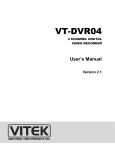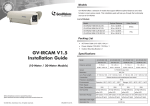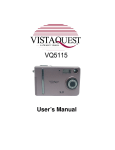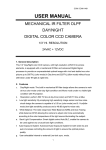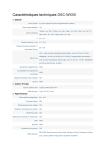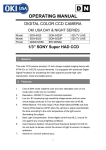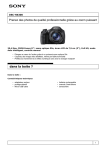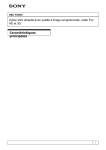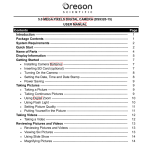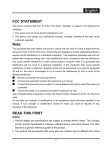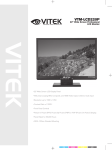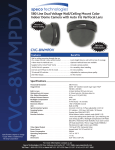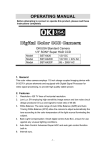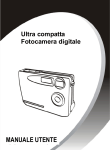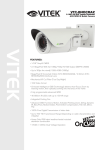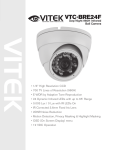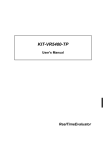Download Manual - Vitek
Transcript
VTC-C594DN 1/3" Hi-Res Day/Night Color CCD Camera INSTRUCTION MANUAL Warning: To prevent fire or electric shock hazard, do not expose the appliance to rain or moisture 1. General This color video camera employs a 1/3” SONY solid-state, charge coupled imaging device, and is equipped with a newly developed DSP (Digital Signal Processor) for video signal processing to provide high color fidelity and a sharp, stable picture. 2. Features 1. Accepts IR illumination for surveillance in total darkness. Delivers color images in daylight and automatically switches to black-white images at night. 2. 420 lines of horizontal resolution and high quality video utilizing digital processing 3. 0.015lux (@ F0.75) Minimum illumination and signal-to-noise ratio of 48 dB is achieved by employing a highly sensitive image sensor with micro lenses and low noise circuit design. 4. High quality picture –A digital signal processor performs digital horizontal and vertical aperture enhancement to produce a high quality picture. 5. A newly developed intelligent wide range Auto Tracing White Balance (ATW) that automatically adjusts the tone according to the color temperature of the light source. 6. Smart digital control Auto BLC, the combination of Histogram equalizer and Central windows weighting BLC functions ensure for use against any unusual lighting conditions. 7. Advanced Auto Exposure System for both fixed iris and auto iris lenses controls the amount of light to ensure optimum video signal. 8. Internal or Line-lock external sync. To prevent electric shock, do not remove screws or covers. There are no user serviceable parts inside. Contact a qualified service person if necessary. 3. Name of Parts and Functions VTC-C594DN A L I K B M C D H N Q J G A. C (CS) mount adapter F E B. Flange focal distance adjustment-If back focus adjustment is necessary, unscrew the flange back lock screw; optimize the focus by turning this ring. C. Mounting screw hole Standard photographic pan-head screw size (1/4” – 20) D. Flange focal lock screw E. Auto iris lens connector (MINI JACK) See 3.1 (Auto-iris connector) F. Video/DC Auto-Iris Lens Selector. DC VIDEO VIDEO---For VIDEO Drive Lens DC------- For DC or D/D Direct Drive Lens G. DC lever Adjuster (VR) For DC D/D auto iris lens drive level adjustment for obtaining correct exposure to light. H. Video output terminal (BNC) This connector is used to connect to the VIDEO IN connector of a monitor or processor. I. ME AE Auto Exposure Mode SW Manual Exposure SW FL FLOFF AES Low Mode SW Manual Shutter speed select SW BLCOFF Auto Backlight ON/OFF SW BLC AUTO IRIS CCD-I Auto Iris Mode SW AI SHUT Auto iris +Shutter Mode SW NORM Pk Av AE Convergence (Av. / Pk ) Manual Gain SW for ME Mode SUPERAGC NAGC AGC Max / Super SW ? =1 ? =.45 GAMMA (.45 / 1) SW 0 1 FL=FLICKERLESS, CCD-I=CCD-IRIS, AI SHUT = AUTO IRIS + SHUTTER SPEED, Av = AVERAGE, Pk = PEAK, AGC=30dB, SUPER=36dB. J. SW2 White Balance mode SW Add. detail see AWB section VBS in 75OHM ON/OFF SW (For Gen-lock model) K. MWB adjust button WB1 WB2 WB3 NC Line-lock Phase Adjustment L. AWB push to lock button Detail pls. See AWB section M. Power pilot LED PTL N. AC24V / DC12V Block Terminal 1.1 Auto Iris Lens Connector Use the accompanying auto iris lens control connector plug. For auto iris lens with built-in EE amp. (VIDEO Type) Set the lens selector switch to ”Video” position. 1 Connector cable leads 2 1.Red---- power 3.White-- video 2.NC 4.Black-- shielded For auto iris lens without EE amp. (DC Type) This is the external view of camera Set the lens selector switch to “DC” position. Connector cable leads 1. Damping coil (-) 3. Driving coil (+) 2. Damping coil (+) 4. Driving coil (-) Connect the leads as shown above; refer to the instructions of the lens. 1.2 1.2.1 Power Terminal AC24V/DC12V model non-polarity DC12V This terminal accepts both AC 24V and DC 12V ~DC2 G NC 1.2.2 Line-Lock Phase Adjustment The vertical phase of the camera video signal can be matched to the phase of the AC power line. Using a dual-trace oscilloscope to observe the video output signal PHASE (V-rate) of the camera and adjust the Line-lock Phase control buttons to line up the phase of both signals Caution: The adjustment must be made by qualified servicing Phase adjusting Buttons for Line-lock model. person or system installer. 3 4 4. White Balance Adjustment Mode selection for each operation as shown in the table below: WB Control Mode Selection Table Mode ATW AWB(conventional) PUSH TO LOCK MWB INDOOR FLUORESCENT FL 2 OUTDOOR SW2 WB1 0 0 0 0 1 1 1 1 WB2 0 1 1 0 0 0 1 1 1.3 ATW mode---- Set the Dip SW. WB1, WB2, WB3 to “0” position, WB3 0 0 1 1 0 1 0 1 0 In this mode, the color temperature is monitoring continuously, and the white balance is set automatically by internal microcontroller. The operating color temperature range is from 2500°K to 9500°K (approximately.) This mode is the default setting when shipped from the factory. 1.4 WB1 WB2 WB3 AWB mode—Conventional auto white balance WB1 WB1=0, WB2=1 , WB3=1 WB2 WB3 1.5 Push to lock mode --- set the Dip SW. WB1=0, WB2=1 , WB3=1 If the camera is used in conditions as described below. The subject is illuminated by several different light sources A sodium lamp, mercury vapors lamp or special effects lamp is used. o The subject has a single color, like blue, red, etc. o A picture with proper tone may not be obtained, in such case please adjust the tone while observing the picture on a color monitor o o 1.6 After setting the dip switches into “push to lock” mode, point the camera at a white object and bring it into focus. 1.6.1 PTL Point at the subject to fulfill the TV screen. Use a light to illuminate the subject. Press the set button, to optimize the picture color. 1.7 Manual mode white balance - set the Dip SW. WB1=0, WB2=0, WB3=1 WB1 1.7.1 WB2 When the dip SW. setting is set to MWB, use the up/down SW. to adjust. 1.7.2 Press the up/down key simultaneously back to 1 WB3 WB1 WB2 WB3 preset white balance position. 1.8 Preset mode white balance 0 1 WB1 WB1 WB1 WB1 WB2 WB2 WB2 WB2 WB3 WB3 WB3 WB3 Indoor 3200°k Outdoor 6300°k Fluorescent 4200°k 4700°k 5. AE Setting AE/ME Dip SW= 0 (AE position) AE MODE CONTROL MODE SW1 AE/ME CCD IRIS MODE (AES) AE FLOFF BLC CCD-I CCD IRIS MODE BLC OFF AE FLOFF BLCOFF CCD-I AES LOW MODE AE FL BLC CCD-I AUTO IRIS MODE AE FLOFF BLC AUTO IRIS AUTO IRIS MODE BLC OFF AE FLOFF BLCOFF AUTO IRIS 1.9 AES Mode(AE/ME=0, CCD-I=0,) (CCD IRIS mode) If you are using a fixed or manual iris lens, please select this mode to control the exposure with the electronic shutter. The range of the shutter speed is from 1/60 to 1/100,000 sec. 1.10 AES LOW Mode (AE/ME=AE, FLOFF/FL=FL position) In order to reduce blurring under low light, in this mode, the shutter is set from 1/100 sec. NTSC to 100,000 sec continuously. 1.11 Auto Iris Mode (AE/ME=AE, CCD-I / AUTO IRIS = CCD-I position) If you are using an auto iris lens, please select this mode, In this mode, the shutter speed is fixed to 1/60 sec. NTSC. 1.12 Auto iris With Shutter speed Mode (AE/ME=AE, AI SHUT at “1” position) This mode has same function as auto iris mode, but with selectable shutter speed by user. This mode is very useful for the application that allows capturing of fast moving objects with higher shutter speed and adequate depth of field. Please refer to table 1 in the ME section for shutter speed selection. AE FLOFF BLC CCD-I NORM Av NAGC ? =.45 ME FL BLCOFF AUTO IRIS AI SHUT Pk SUPERAGC ? =1 0 AE FLOFF BLC CCD-I NORM Av NAGC ? =.45 1 ME FL BLCOFF AUTO IRIS AI SHUT Pk SUPERAGC ? =1 0 AE FLOFF BLC C-IRIS NROM Av AGC ? =.45 1 ME FL BLCOFF A-IRIS AI SHUT Pk SUPER ? =1 0 AE FLOFF BLC CCD-I NORM Av NAGC ? =.45 1 ME FL BLCOFF AUTO IRIS AI SHUT Pk SUPERAGC ? =1 6. Me Setting AE/ME DIP SW = ME 0 Dip SW “FL”, “BLC”, and “CCD-I” for setting the shutter speed from 1/60 to 1/10,000 sec. In addition, the GAIN can be selected from 0 to 18 dB by DIP SW of “Av/Pk” and “NAGC/SUPERAGC”. For details, please refer to table 1 for Shutter speed and table 2 for Gain setting. Shutter speed (table 1) SHUTTER SPEED 1/60 SEC 1/100 SEC 1/250 SEC 1/500 SEC 1/1000 SEC 1/2000 SEC 1/4000 SEC 1/10000 SEC Gain control (Table 2) GAIN 0 dB 6 dB 12dB 18dB AE/ME ME ME ME ME ME ME ME ME ME FL BLCOFF AUTO IRIS AI SHUT Pk SUPERAGC ? =1 AE FLOFF BLC CCD-I NORM Av NAGC ? =.45 FLOFF FL FLOFF FL FLOFF FL FLOFF FL AE/ME ME ME ME ME BLC BLC BLCOFF BLC OFF BLC BLC BLC OFF BLC OFF Av Pk Av Pk SHUTTER SPEED GAIN SETTIN CCD-I CCD-I CCD-I CCD-I AUTO IRIS AUTO IRIS AUTO IRIS AUTO IRIS NAGC NAGC SUPERAGC SUPERAGC 7. Auto Back-light Compensation BLC ON BLC BLC OFF BLCOFF BLC BLCOFF This intelligent auto BLC is a newly developed digital light level control system, it is activated automatically by screen histogram (contrast) and 225 area window weighting integration to control iris gain and white balance simultaneously, so that the optimum object light level can be achieved. 1.13 Central Window Weighted average Backlight compensation This method is best used in cases where the main subject is fixed within the screen. 1.14 Histogram Backlight compensation This method is best used in cases where the main subject moves about within the screen image. 1.15 The combination of two types of Backlight makes it easier to arrange the compensation operation to match the imaging conditions and installation location. Note: Compensation may be insufficient under extremely bright conditions. 8. Infra-Red projection In a low light environment, a standard color camera cannot obtain a clear picture with an IR illuminator. This camera has been specially designed with the capability to accept most IR projection, delivering a clear black and white picture under absolute darkness. The Infrared wavelength is from 800nm to 1000nm. The focus may vary slightly with IR wavelength due to lens diffraction to long-wave. When installing the camera with an IR projector, please check the focus under IR illumination and normal light conditions, to find an adequate medium focusing position. It is recommended to close the lens aperture one or two stops to increase the depth of field and compensate for the lens diffraction. 9. Specifications Image device 1/3” interline transfer SONY Super HAD CCD Signal system NTSC standard Picture Elements 537(H) x 505(V) STD Scanning system 525 lines. 2:1 interlace Sync system DC 12V / AC 24V Line-lock Horizontal resolution 420 TV lines Minimum illumination 0.015 lux at F0.75 / 0 lux under Infra-red illumination Infra-red wavelength From 800nm to 1000nm Aperture correction H aperture and V aperture Gain Max. Gain 30dB; Super Gain 36 dB S/N ratio Better than 48dB Auto exposure system 4 modes selectable by Dip-switch AE CCD iris mode 1/60 sec. \ 1/100,000 sec. AE AES low mode 1/100 sec. \ 1/100,000 sec. AE Auto iris mode 1/60 sec. AE Auto iris + shutter speed mode 1/60 \ 1/10,000 sec. AE level Average, Peak selectable Manual exposure system Shutter: 1/60, 100, 1/250, 1/1,000, 1/2,000, 1/ 4,000,1/10,000 sec. / Gain: 0,6,12,18dB Auto iris lens Accepts Video or DC servo iris lens ATW 2500°K to 9500°K AWB Push To Lock and Conventional AWB MWB R Gain, B Gain FWB Indoor 3200°K , Fluorescent1 4200°K, Fluorescent2 4700°K, outdoor 6300°K. Gamma 45 / 1 Backlight compensation Auto Detect On/off; Histogram plus windows weight BLC Video output signal Composite: 1 V p-p at 75 Ohm Lens mount C & CS mount Operating temperature 14°F to 122°F (-10°C to 50°C) Power source AC 24V /DC 12V (Non-polarity) Power consumption 3.5W (DC type) / 5.5W (AC type) Dimensions (W x H x D) 2.25” x 2.05” x 4.33” (57 x 52 x 110mm) 9970 GLENOAKS BLVD. UNIT B SUN VALLEY, CA 91352 PHONE: 888-VITEK-70 818-771-0300 FAX: 818-771-0400 WWW.VITEKCCTV.COM








